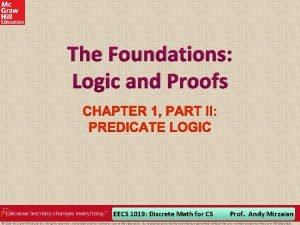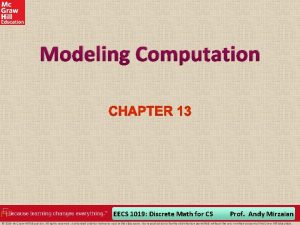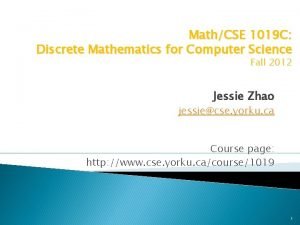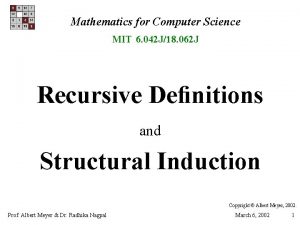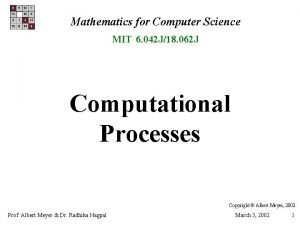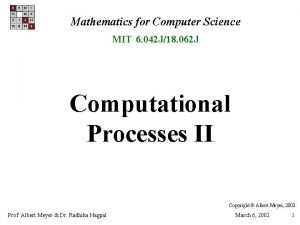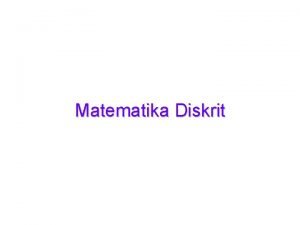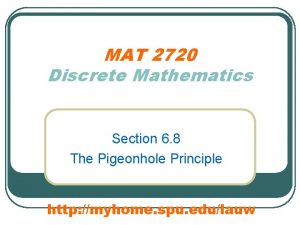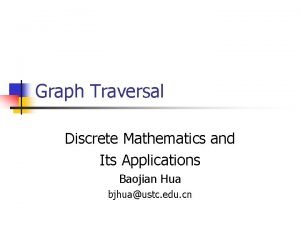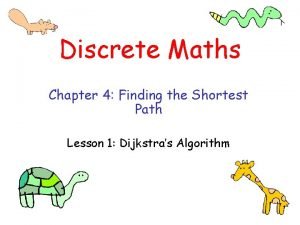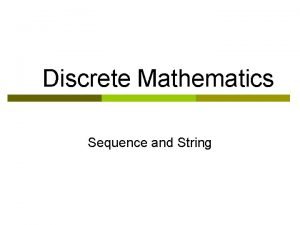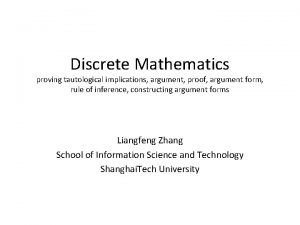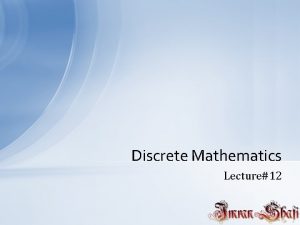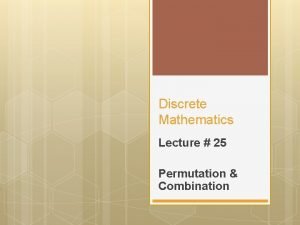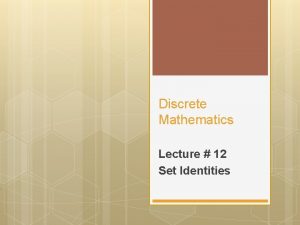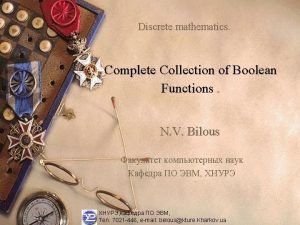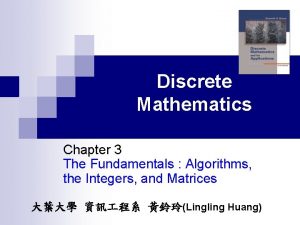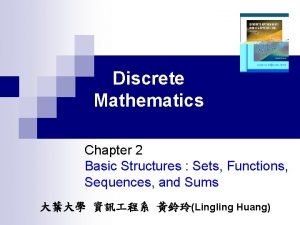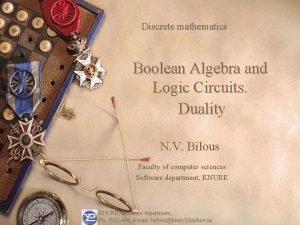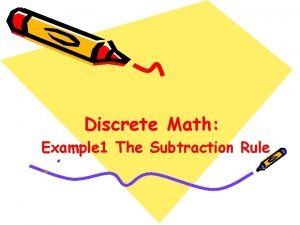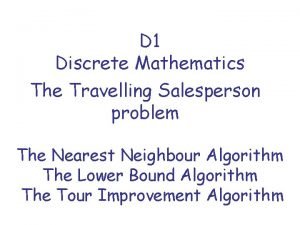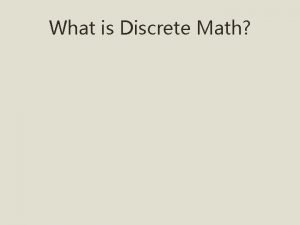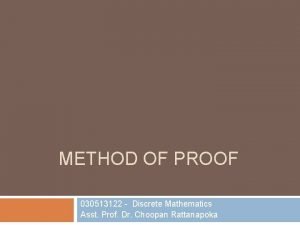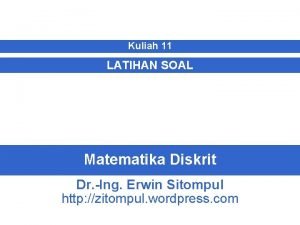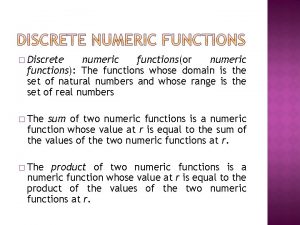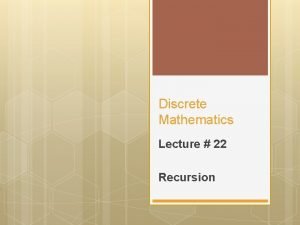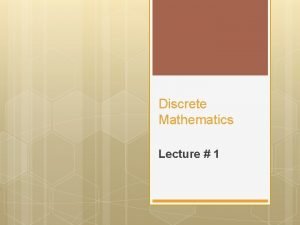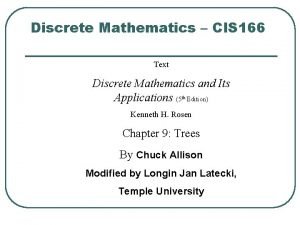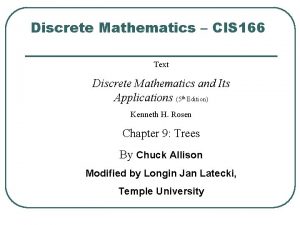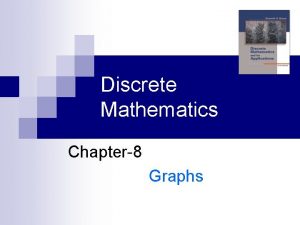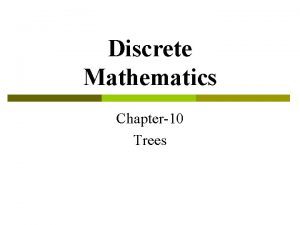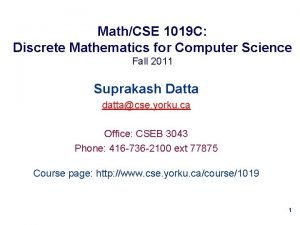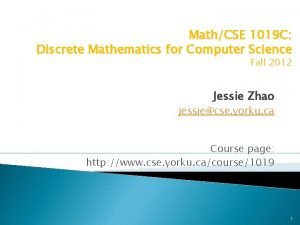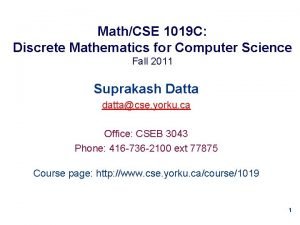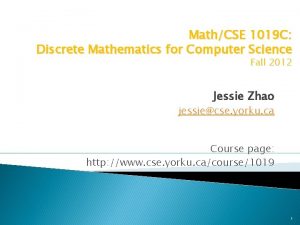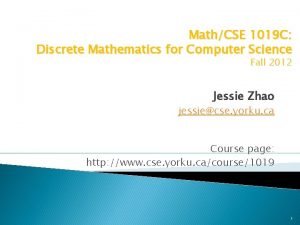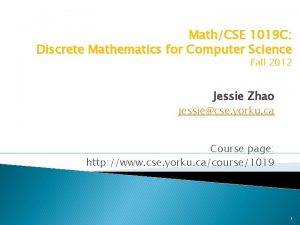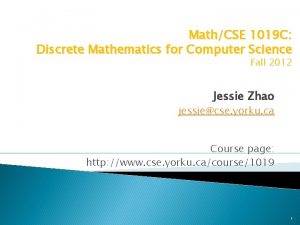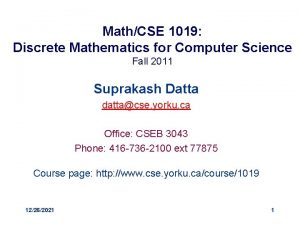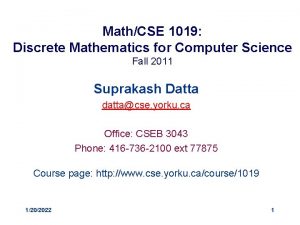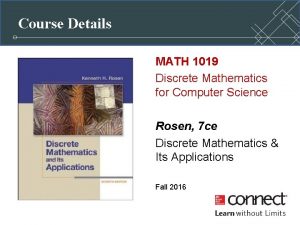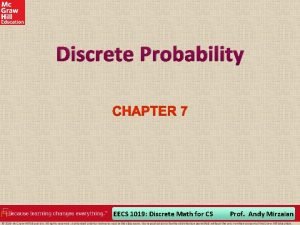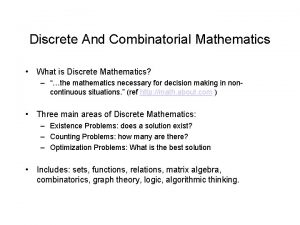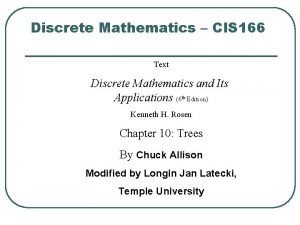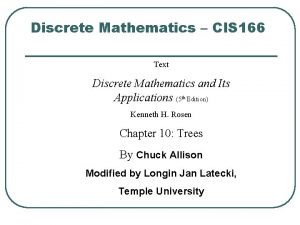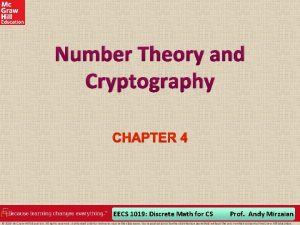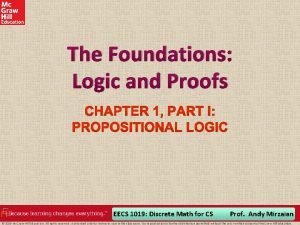MathCSE 1019 C Discrete Mathematics for Computer Science




































- Slides: 36

Math/CSE 1019 C: Discrete Mathematics for Computer Science Fall 2012 Jessie Zhao jessie@cse. yorku. ca Course page: http: //www. cse. yorku. ca/course/1019 1

No Assignment is released today! No Class on Thanks Giving! Oct 8 th Test 1 on Oct 15 th, ◦ ◦ Ch 1. 1 -1. 8 7 pm-8: 20 pm Location: SLH F Lecture: 8: 40 pm, SLH A. 2

Review of Sets What is a set? ◦ Unordered collection of distinct elements How to describe a set? Roster method: A={5, 7, 3} set builder (predicates): S = {x | P(x)} Cardinality |S| number of (distinct) elements |A| = 3 3

Exercises 1. 2. 3. What is the cardinality of {∅, {∅}}}? What is its power set? Prove that A ⊂ B iff P(A) ⊂P(B). Draw the Venn Diagrams for 4

Review of Functions A function from A to B is an assignment of exactly one element of B to each element of A. grade: S → G S G 5

This is not a function! S G Jason Every member of the domain must be mapped to a member of the co-domain 6

This is not a function! S G No member of the domain may map to more than one member of the co-domain 7

Surjections (onto) Injections (1 -1) Bijections (1 -1 correspondence): Invertible 8

Graphs of Functions Let f: A➝B. The graph of f is the set of ordered pairs {(a, b) | a∈A and f(a)=b} Example: The graph of f: Z->Z where f(x)=2 x+1 9

The Graph of Floor function R->Z ◦ ⌊x⌋ is the largest integer that is less than or equal to x. 10

The Graph of Ceiling function R->Z ◦ ⌈x⌉ is the smallest integer that is greater than or equal to x. 11

Let f and g be functions from A to R. Then f 1+f 2 and f 1 f 2 are also functions from A to R ◦ (f 1+f 2)(x) = f 1 (x) + f 2 (x) ◦ (f 1 f 2)(x) =f 1 (x) f 2(x) Example: f 1(x)=x, f 2(x)=x² (f 1+f 2 )(x)=x + x² (f 1 f 2 )(x)= x³ Notice the difference between and fg 12

Monotonic Functions The domain and codomain of f are subsets of R. x, y are in the domain of f and x<y. f is (monotonically) increasing if f(x)≤f(y) f is strictly increasing if f(x)<f(y) f is (monotonically) decreasing if f(x)≥f(y) f is strictly decreasing if f(x)>f(y) Increasing Decreasing Not Monotonic 13

More Exercises for functions Show that ⌈x+n⌉ is ⌈ x ⌉ +n for x∈R and n∈Z. Proof: ◦ ◦ ◦ Assume ⌈ x ⌉ = m. m-1 < x ≤ m n+m-1 < x+n ≤ m+n ⌈ x+n ⌉ = m+n = ⌈ x ⌉ +n Q. E. D. 14

More Exercises for functions Show that ⌊2 x⌋ is ⌊ x ⌋ + ⌊ x+1/2 ⌋ for x∈R. Proof: ◦ ◦ ◦ ◦ ◦ Assume x=n+e where n∈Z, e∈R and 0≤e<1. Case 1: 0≤e<1/2 ⌊ 2 x⌋= ⌊ 2 n+2 e ⌋ = 2 n (0≤ 2 e<1) ⌊ x ⌋ = ⌊ n+e ⌋ = n (0≤e<1/2) ⌊ x+1/2 ⌋ = ⌊ n+e+1/2 ⌋ = n (1/2≤e+1/2<1) So, ⌊ 2 x ⌋ = ⌊ x ⌋ + ⌊ x+1/2 ⌋ Case 2: 1/2≤e<1 ⌊ 2 x⌋ = ⌊ 2 n+2 e ⌋ =2 n+1 (1≤ 2 e<2) ⌊ x ⌋ = ⌊ n+e ⌋= n (1/2≤e<1) ⌊ x+1/2 ⌋ = ⌊ n+e+1/2 ⌋ = n +1 (1≤e+1/2<1 1/2) 15

More Exercises for functions Changing bases: In general need to go through the decimal representation E. g: 1017 = ? 9 1017 = 1*72 +0*71 + 1*70 = 50 Decimal to Base 9: d 1 = n rem 9 = 5, n = n div 9 = 5 b 2 = n rem 9 = 5, n = n div 9 = 0. STOP So 1017 = 559 16

More Exercises for functions Changing bases that are powers of 2: Can often use shortcuts. Binary to Octal: 10111101 = 2758 Binary to Hexadecimal: 10111101 = BD 16 Hexadecimal to Octal: Go through binary, not decimal. 17

More Exercises for functions 1. Prove that a strictly increasing function from R to itself is one to one 2. Suppose that f: Y->Z and g: X->Y are invertible. Show that 18

Sequences A sequence is an ordered list, possibly infinite, of elements notated by {a₁, a₂, a₃. . . } or where k is the upper limit (usually ∞) A sequence is a function from a subset of the Z (usually {0, 1, 2, . . . }) to another set an is the image of the integer n. We call an a term of the sequence, and n is its index or subscript 19

Arithmetic Progressions An arithmetic progression is a sequence of the form a, a+d, a+2 d, a+3 d, . . . , a+(n-1)d, . . . a is the initial term d is the common difference E. g. ◦ {-1, 3, 7, 11, . . . } ◦ {7, 4, 1, -2, . . . } 20

Geometric Progressions An geometric progression is a sequence of the form a, ar², ar³, . . . , arⁿ, . . . a is the initial term r is the common ratio E. g. ◦ {1, -1, 1, . . . } ◦ {2, 10, 50, 250, 1250, . . . } 21

Useful Sequences {n²}: 1, 4, 9, 16, 25, . . {n³}: 1, 8, 27, 64, 125, . . . {n ⁴}: 1, 16, 81, 256, 343, . . . {2ⁿ}: 2, 4, 8, 16, 32, . . . {3ⁿ}: 3, 9, 27, 81, 243, . . . {n!}: 1, 2, 6, 24, 120, . . . {fn}: 1, 1, 2, 3, 5, 8, … 22

Series A series is the sum of the terms of a sequence S = a 1 + a 2 + a 3 + a 4 + … Consider the sequence S 1, S 2, S 3, … Sn, where Si = a 1 + a 2 + … + a i In general we would like to evaluate sums of series – useful in algorithm analysis. e. g. what is the total time spent in a nested loop? 23

Summations Given a sequence {ai} the summation notation for its terms am, am+1, . . . , an represent am + am+1 + … + an E. g. 24

Summation of Arithmetic Progression Given a arithmetic progression a, a+d, a+2 d, a+3 d, . . . , a+nd, its summation is Proof on board You should also be able to determine the sum if the index starts at k and/or ends at n-1, n+1, etc. Page 166: useful summation formula 25

Summation of Geometric Progression Given a geometric progression a, ar², ar³, . . . , arⁿ, its summation is Proof on board You should also be able to determine the sum if the index starts at k and/or ends at n-1, n+1, etc. 26

Infinite series Let x be a real number with |x|<1. Find How about |x|≥ 1? Need to be very careful with infinite series In general, tools from calculus are needed to know whether an infinite series sum exists. 27

Double Summation loop 1: for i=1 to 4 loop 2: for j=1 to 3 S = S + ij 28

Cardinality Recall: A set is finite if its cardinality is some (finite) integer n For two sets A and B ◦ |A| = |B| if and only if there is a bijection from A to ≤ |B| if there is an injection from A to B = |B| if |A| ≤ |B| and |B| ≤ |A| ≤ |B| if A⊆B 29

Infinite sets Why do we care? Cardinality of infinite sets Do all infinite sets have the same cardinality? 30

Countability A set is countable if ◦ it is finite or ◦ it has the same cardinality as the set of the positive integers Z⁺ i. e. |A| = |Z⁺|. The set is countably infinite We write |A| = |Z+| = ℵ 0= aleph null A set that is not countable is called uncountable 31

Countability implies that there is a listing of the elements of the set. Fact (Will not prove): Any subset of a countable set is countable. Proving the set is countable involves (usually) constructing an explicit bijection with Z⁺ 32

Show that the set of odd positive integers S is countable. Proof: ◦ To show that S is countable, we will show a bijective function between Z⁺ and S. ◦ Consider f: Z⁺ ->S be such that f(n) = 2 n-1. ◦ To see f is one-to-one, suppose that f(n)=f(m), then 2 n 1=2 m-1, so n=m. ◦ To see f is onto, suppose that t∈S, i. e. t=2 k-1 for some positive integer k. Hence t=f(k). ◦ Q. E. D. 33

The integers are countable Write them as 0, 1, -1, 2, -2, 3, -3, 4, -4, …… Find a bijection between this sequence and 1, 2, 3, 4, …. . Notice the pattern: 1 0 2 1 3 -1 4 2 5 -2 6 3 So f(n) = n/2 if n even -(n-1)/2 o. w. 34

Other simple bijections Union of two countable sets A, B is countable: Say f: N A, g: N B are bijections New bijection h: N A B h(n) = f(n/2) if n is even = g((n-1)/2) if n is odd. 35

The rationals are countable Step 1. Show that Z+ x Z+ is countable. Step 2. Show injection between Q+, Z+ x Z+. Step 3. Construct a bijection from Q+ to Q 36
 Nested quantifiers
Nested quantifiers Modeling computation discrete math
Modeling computation discrete math Eecs 1019
Eecs 1019 Mathematics for computer science mit
Mathematics for computer science mit Mathematics for computer science mit
Mathematics for computer science mit Mathematics for computer science mit
Mathematics for computer science mit Kenneth rosen discrete mathematics solutions
Kenneth rosen discrete mathematics solutions Pigeonhole principle in discrete mathematics
Pigeonhole principle in discrete mathematics Proof by contradiction discrete math
Proof by contradiction discrete math Kesetaraan logis adalah
Kesetaraan logis adalah Bfs in discrete mathematics
Bfs in discrete mathematics Shortest path problem in discrete mathematics
Shortest path problem in discrete mathematics String in discrete mathematics
String in discrete mathematics Tautological implication
Tautological implication Converse of a relation
Converse of a relation Propositional logic puzzles
Propositional logic puzzles Permutation and combination in discrete mathematics
Permutation and combination in discrete mathematics Set difference identities
Set difference identities Boolean functions in discrete mathematics
Boolean functions in discrete mathematics Discrete probability and advanced counting techniques
Discrete probability and advanced counting techniques The value of 52003 mod 7 is?
The value of 52003 mod 7 is? Onto function
Onto function De morgan's law in propositional logic
De morgan's law in propositional logic Duality digital logic
Duality digital logic Incidence matrix in discrete mathematics
Incidence matrix in discrete mathematics Subtraction rule in discrete mathematics
Subtraction rule in discrete mathematics Travelling salesman problem discrete mathematics
Travelling salesman problem discrete mathematics What is discrete mathematics
What is discrete mathematics Pqqpq
Pqqpq Soal kuliah matematika
Soal kuliah matematika Numeric function in discrete mathematics
Numeric function in discrete mathematics Recursion in discrete mathematics
Recursion in discrete mathematics Declarative statement in discrete mathematics
Declarative statement in discrete mathematics M ary tree in discrete mathematics
M ary tree in discrete mathematics M ary tree in discrete mathematics
M ary tree in discrete mathematics Working memory graphs
Working memory graphs What is rooted tree in discrete mathematics
What is rooted tree in discrete mathematics
